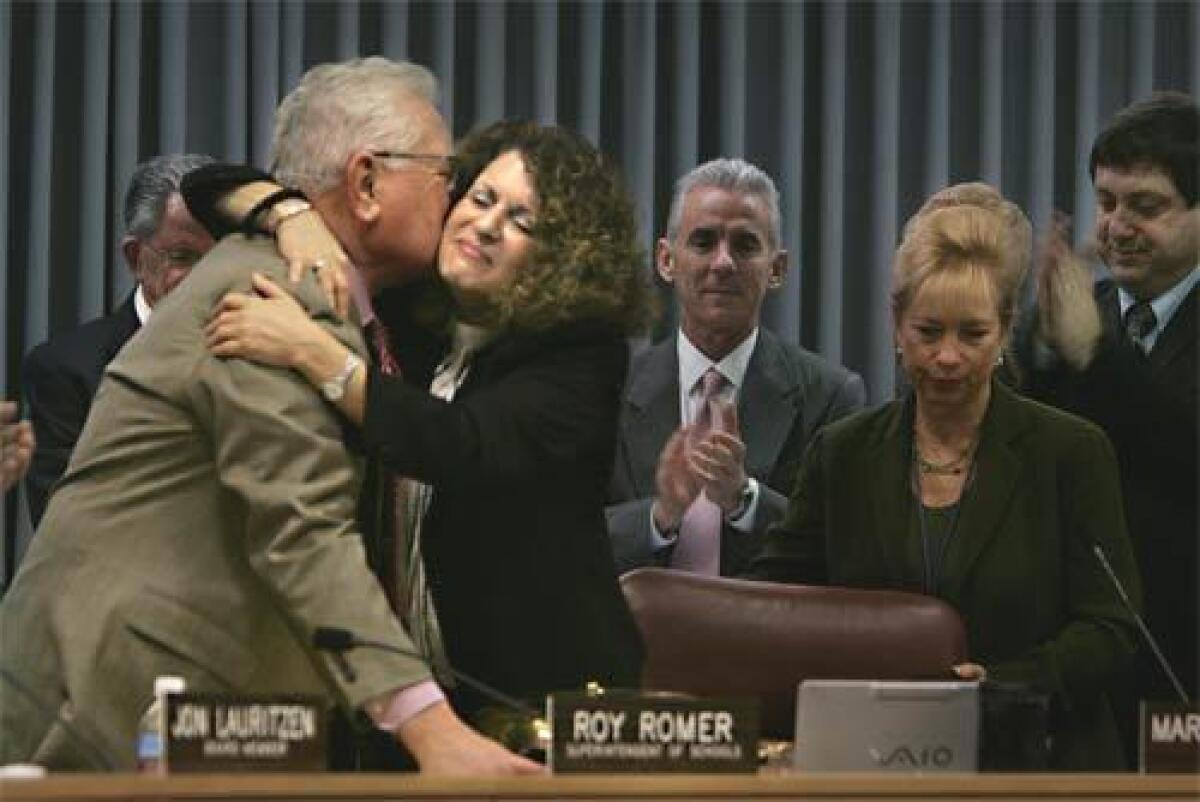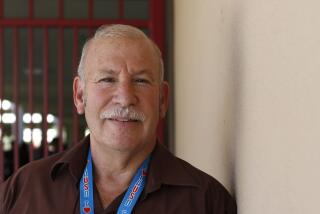Brewer gets no honeymoon at L.A. Unified

Since being tapped for the job a month ago, incoming Los Angeles schools chief David L. Brewer has crisscrossed the sprawling school district for an exhausting string of meetings with teachers, parents and power brokers.
It was an energetic early effort by the inexperienced but high-stamina retired Navy vice admiral to grasp the scope and magnitude of the challenges he inherits. In coming months, Brewer will have to deal with the ongoing wrestling match for power between the school board and Los Angeles Mayor Antonio Villaraigosa, plus contract negotiations with an angry teachers union and a host of academic trouble spots.
FOR THE RECORD:
Class sizes: A Nov. 15 article in the California section about a union grievance reported claims by officials of United Teachers Los Angeles that Millikan Middle School in Sherman Oaks has physical education classes with more than 100 students. Millikan’s largest classes have 64 students, according to records supplied by the school. —
The preliminaries ended Tuesday as Brewer formally replaced outgoing Supt. Roy Romer and immediately had to face a grievance filed by the teachers union over class sizes.
“I am looking forward to working with the children,” said Brewer, 60, in his first comments from his seat at the horseshoe dais of the boardroom. “Because that is who I work for — make no mistake about it . Roy Romer, you have left me a great foundation. It is now my job to build skyscrapers on top of your foundation.”
Making a point to say people should stop addressing him by his military rank in favor of his new title of superintendent, Brewer appeared comfortable and excited on his first day.
He smiled broadly as a student drum corps and color guard welcomed him with patriotic songs. When bantering with visiting staff from Francis Polytechnic High, he recited from memory the school’s test scores, and made a Poly student smile when he recognized her from a visit he had made to the campus.
But elsewhere in the district, the rhetoric was far from celebratory, as teachers revved up for the filing of their grievance by leading a media bus tour to call attention to crowded classrooms at four schools: Carson, Roosevelt and Fremont high schools and Sepulveda Middle School.
Leaders of United Teachers Los Angeles insisted the event wasn’t scheduled to upstage Brewer, but the issue immediately rises to the top of the agenda as part of a contentious contract negotiation.
District officials admit they are not adhering to class size levels specified in the teachers contract. But the school system is allowed to increase class size unilaterally during periods of financial hardship.
The latest increase — of about two students per class at most grade levels — took effect in the 2002-03 school year in the wake of a state budget crunch and two years after an 11.9% teacher salary increase that critics had decried as too costly.
Because L.A. Unified specifies no class-size maximums, the union had no problem assembling horror stories, including an Advanced Placement statistics class at Chatsworth High with 46 students. The picture is especially bad in physical education, which suffers from being considered a low academic priority. The union tabulated four PE classes at Millikan Middle School in Sherman Oaks with more than 100 students each.
Roosevelt High history teacher Gillian Russom has 173 students over five periods. Her largest class, with 37 students, includes 19 with special needs — either learning disabilities or a limited ability to speak English.
“How can our society expect one individual to give each to these students the education they deserve?” Russom asked.
Teachers union President A.J. Duffy was in full confrontation mode in attacking the central office: “If they cared about kids half as much as they cared about their fiefdoms, we wouldn’t have to do this. They have more money than God. It’s just they way they choose to use it.”
According to district data, last year’s average high school English class had 27 students; math and social science classes averaged 35 students. State data indicate that class sizes in L.A. Unified are on par with those in other California school systems.
At district headquarters after the bus tour, union leaders presented documents to board member Jon Lauritzen, one of their closest allies and a candidate for reelection. The symbolic hand-over took place on the sidewalk, sparing Brewer a direct confrontation for now.
In a brief interview earlier in the day, Brewer wasted no time weighing in on the delicate contract negotiations with UTLA, indicating he thinks a 3% raise for teachers is reasonable.
“I’ve looked back over time to see what the average is for teachers, and its been about 3%,” he said, echoing the district’s current offer. “I’m going to jump right into collective bargaining.”
Union leaders have demanded 9%. The district’s offer also includes maintaining current health benefits, which increases the compensation package by 1.5%. The district also has put $10 million on the table for reductions in class sizes. UTLA’s Duffy called that “insulting,” saying it would cost $30 million to lower class sizes by one student.
On another divisive issue, Brewer backed off from comments he made about teachers last month. He had irritated union officials when he promised to make removing “bad teachers” from classrooms a major focus of his reform plans.
Instead, Brewer pledged Tuesday to improve teacher performance by increasing the number of days each year they are pulled out of the classroom to receive training.
“We do not have enough professional development days for our teachers. That is what is impacting the quality of teaching,” he said. “Let’s keep this positive.”
Brewer said he would leave decisions about removing problem teachers “up to the principals and the local [officials].”
Noticeably absent from Tuesday’s ceremonies were Villaraigosa and members of his staff. The mayor remains at odds with school board members over his efforts to gain substantial authority over district schools. But he has so far hit it off with Brewer, with whom he appeared Monday at an event in Watts promoting a citywide day of service.
The new superintendent offered no concrete plans during Tuesday’s interview, but reiterated his intention to make reforms in the district’s middle and high schools a top priority. Romer oversaw dramatic improvements in elementary schools; he paid less attention to the lower-performing higher grades.
Board members and politicians began their farewells to Romer before Brewer arrived Tuesday morning.
His face tight with emotion, the 78-year-old former Colorado governor listened as a chorus of young students sang to him and staunch supporters and sometime critics alike gave impromptu thanks.
“You brought to this district a common sense and leadership that I don’t think many of the naysayers had seen before,” said board member Mike Lansing.
“We had our times when we agreed thoroughly and we had our times when we didn’t,” said state Assemblywoman Jackie Goldberg (D-Los Angeles).
“But it didn’t really matter,” she said, “because I knew that your heart and head were in the right place, that you wanted to get things done on behalf of the children.”
Many who spoke reiterated that Romer would be remembered most for his deft shepherding of the district’s $19.3 billion construction project that aims to build about 150 schools by 2012 to relieve severe crowding on many campuses.
Indeed, the most poignant moment of the morning came when district officials recommended to the board that a new middle school in the San Fernando Valley be named after Romer.
Romer struck a self-effacing note, giving much of the credit for his successes to others.
“I don’t know of any more important issue than finding a way to better educate our children and not educate them just in terms of problem solving and problems of the mind, but to educate them in the possibilities of the heart,” he said after the first of two standing ovations.
“To have been given the opportunity to be a part of this for six years, I am just grateful. I leave more humble than I came.”
*
joel.rubin@latimes.com
howard.blume@latimes.com
More to Read
Start your day right
Sign up for Essential California for news, features and recommendations from the L.A. Times and beyond in your inbox six days a week.
You may occasionally receive promotional content from the Los Angeles Times.








